
Vol. 8, No. 1, January 2012 |
 Printer-Friendly PDF Version Printer-Friendly PDF Version |
New SART Planner
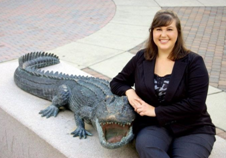
Bianca Blakley is the new SART Planner, replacing Michael Turner who moved to the Washington, DC area to work for Booz-Allen-Hamilton consulting. Bianca is on contract with the Office of Agricultural Law to work inside the Division of Animal Industry under the supervision of ESF-17 Joe Kight, Senior Management Analyst II.
Bianca recently graduated from UF with a degree in Agricultural Education and Communication, specializing in Communication and Leadership Development. She also studied print design and video editing, and produced a series of videos about scientific research at UF for a video wall exhibit at the Florida Museum of Natural History.
Calling herself a “non-traditional student,” Bianca worked several years as a store manager for Midwest Feed & Farm. A Polk County native, Bianca grew up in 4H programs, showing horses and raising market hogs (she especially recalls her Duroc cross and a Hampshire cross).
At present, Bianca [Bianca.Blakley@freshfromflorida.com] is getting to know the response community, updating brochures, planning a new SART video, working on the preliminaries of a 2013 Planning Meeting and “coming up to speed” on FEMA coursework. Welcome, Bianca!
[top]
Advisory Board Meeting Scheduled
Florida SART Advisory Board members, presenters and invited guests should mark their calendar for April 4th for the next Advisory Board meeting which will be held from 10:00 AM to 2:00 PM at the FDACS office, 14101 NW Highway 441 in Alachua, Florida.
Please watch for the February and March editions of the SART Sentinel for additional information.
[top]
Animal Tracking During Disasters: New Technology May Help
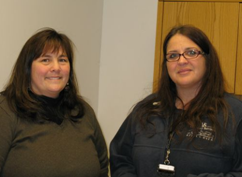
USDA's Kim Duffiney (l) and Melinda Springer discuss MIM at a recent meeting of the SART Steering Committee.
Melinda Springer, Animal Health Technician with USDA/APHIS/VS, is experimenting
with MIM Technology – MIM standing for Mobile Information Management – that will allow responders and shelter workers to identify and track animals during and in the aftermath of a disaster. A pilot project with St. Johns County Animal Control (and one in Alachua County) will soon be underway and could run for several weeks.
“We want to know if MIM is a workable technology in a practical, hands-on environment,” Springer says. “It works on paper, but in the hectic, rough-and-tumble atmosphere of a shelter in an emergency – well, it hasn’t really been put to the test yet and we want to move a step in that direction. Right now we can only hypothesize that it is practical and cost-effective. If MIM is the answer to tracking animals for emergency purposes we want to establish some guidelines and perhaps a training program for animal responders and shelter workers.” MIM applications have proven successful in areas associated with disease testing and surveillance in livestock.
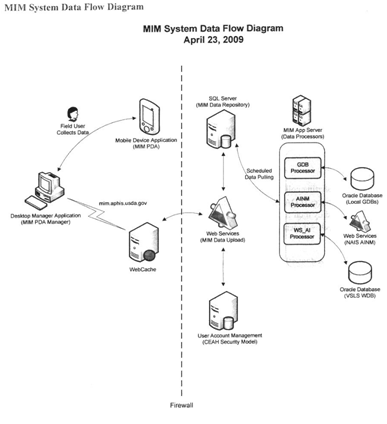
This chart depicts the flow of information within USDA/APHIS/VS, but data gathered can be obtained in many formats to upload into different systems.
For those who are not yet familiar with MIM, it is an electronic system used to account for animals in emergency situations. Animals could be a house cat inside a cage in a shelter or a horse loose in a pasture. Basically, an operator uses a PDA (personal data assistant) with scanning technology (and SART now has 8 PDA’s) to capture animal and owner information and link the information to a unique number printed in the form of a water resistant barcode. The barcode is then placed on a Tyvek band which is also water resistant. The band is attached to an animal or its cage or enclosure and, with other information captured at the time of animal intake, the scanned bar code identifies the animal. The animal can then be tracked by computer – including other networked computers – through shelter intake, release and even adoption. The pet’s owner gets an identical barcoded Tyvek band at intake. To ensure each person leaves with the animal they brought into the shelter, a worker simply scans the barcoded bands of an animal and the owner to verify that they match upon release.
Such a tracking and information-maintenance system is required by the “Pets Act” (Stafford Act of 2006), Springer says.
[top]
Large Animal Rescue Training Pays Dividends – Midnight's Rescue
Submitted by John Haven, Director, UF CVM
On December 30, 2011, Midnight and its owner strayed from the path at Paynes Prairie Preserve State Park, and the 1,000 pound Tennessee Walker sunk in the mud about 35 yards from safety. Midnight’s successful rescue is a story of a combined agency effort, plus training and coordination before an actual incident occurred.
Park Rangers responded immediately to the incident. They contacted the Alachua County Sheriff’s Office, which has deputies trained to handle livestock issues. The Sheriff dispatched rural services deputies Perry Koon and Danny Buckley.
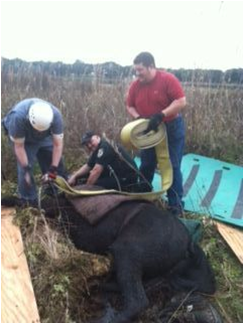
VETS team members John Haven and Dr. Roger Clemmons prepare webbing to move Midnight while Alachua County Sheriff's Deputy Danny Buckley maintains control of the horse's head (Photo courtesy Dr. Cate Mcmanus)
Koon had trained in large animal rescue with the UF College of Veterinary Medicine’s VETS Disaster Response Team. He knew the VETS Team had the equipment needed for this large animal emergency, and requested the team’s help. The VETS team responded, as did large animal veterinarian Dr. Randy Emmons.
Park Rangers provided plywood sheets from their hurricane cache. The plywood served as decking, allowing responders safe access to the trapped horse and smooth egress over difficult terrain.
Helping Midnight proved to be more than a “simple mud rescue.” Roots and other hazards had to be cleared from the bog before the animal’s trapped limbs were freed. Also, with the horse far out from shore, the VETS team’s A-frame vertical lift was out of the question.
The team decided to sedate the horse and roll out the “Rescue Glide,” similar to a stretcher for a horse. From there, a mechanical advantage system (a sling) was used to pull the horse, and deputy Buckley, who had remained with the horse’s head, to hard ground. Dr Emmons gave Midnight a physical examination, and several liters of intravenous fluid. As darkness fell, Midnight awakened, and stood. After an additional check for lameness, Midnight walked with the owner and Park Rangers back to the awaiting trailer.
Recognizing that Midnight had a long and stressful day, the owner took an often overlooked step with a large animal technical rescue – scheduled a follow up visit with Midnight’s normal doctor the next day. (Too often after a horse is on its trailer, the owner assumes all is well, without recognizing the equine has been through a lot, and lying on its side for an extended time is not normal. Midnight had a full follow up visit, and is doing great.)
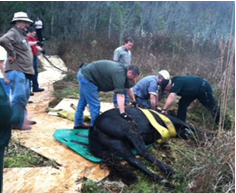 | 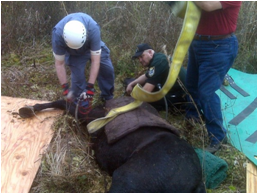 |
Photos courtesy Alachua County Sheriff’s Office | |
A two-day Large Animal Technical Rescue “operations level” course, is taught by the UF CVM VETS team, and is aimed at sheriff, fire, county animal control, or other agencies and NGO’s who will typically respond to large animal technical rescue situations. This course, developed in conjunction with IFAS, has been accepted by the Florida Division of Emergency Management, and is available for use with DHS funds. Schedule the course in your area by contacting VETS team leader John Haven (havenj@ufl.edu).
[top]
Training Through FDACS & Indian River
The Western Institute for Food Safety and Security of University of California-Davis in collaboration with the Florida Department of Agriculture and Consumer Services and the Regional Domestic Security Task Forces is offering the following Dept. of Homeland Security (DHS) certified agroterrorism awareness courses in Florida. The courses are open to all US citizens, and are free of charge (lunch not provided) through DHS grant funding.
Thursday, February 9
AWR 155 Principles of Frontline Response to Agroterrorism and Food Systems’ Disasters
Registration at 7:30 am; Workshop from 8:00 am to 4:00 pm
Indian River Research and Education Center, 2199 South Rock Road, Fort Pierce, FL 34945
Friday, February 10
AWR 156 Principles of Planning and Implementing Recovery
Registration at 7:30 am; Workshop from 8:00 am to 4:00 pm
Indian River Research and Education Center, 2199 South Rock Road, Fort Pierce, FL 34945
Thursday, February 16
AWR-152 Principles of Preparedness for Agroterrorism and Food Systems’ Disasters
Registration at 7:30 am; Workshop from 8:00 am to 4:00 pm
Volusia County Health Department, 1845 Holsonback Drive, Conference Room 516C, Daytona Beach, FL 32117
Friday, February 17
AWR-156 Principles of Planning and Implementing Recovery
Registration at 8:00 am; Workshop from 8:30 am to 3:30 pm
USDA Farm Service Agency, 4401 NW 25th Place, Suite M (a few doors down from Ichiban Sushi), Gainesville, FL 32606
To find additional information about each course and to register on-site please visit http://dhs.wifss.ucdavis.edu/agroterrorism/classes/classesbydate.php.
If you have any questions please contact John Burkette at (850) 245-1387 or email John.Burkette@freshfromflorida.com
 |
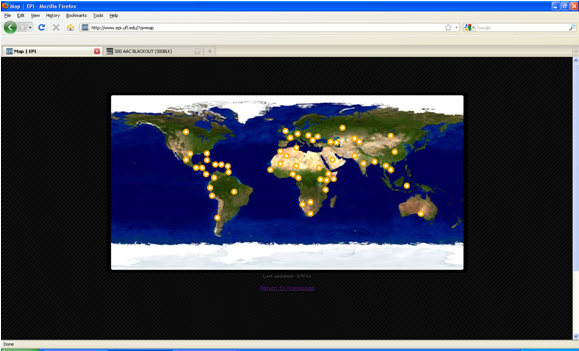 |
Glenn Morris, Michael Batz and Sandra Hoffman of the Emerging Pathogens Institute at UF say that the global food production network presents safety challenges unheard of in the past. “Food that used to come from the backyard or the orchard behind the house is now produced and shipped from thousands of miles away,” Morris says. To read their report, Ranking the Risks: The 10 Pathogen-Food Combinations with the Greatest Burden on Public Health go to www.epi.ufl.edu/?q=RankingTheRisks. The site also includes an informative video presentation. Out of curiosity… What would you think is the leading, disease-causing bug overall? Is it (A) Poultry contaminated with Camplylobacter bacteria, (B) Salmonella-contaminated produce, eggs, poultry and multi-ingredient foods, (C) Listeria in meats and cheeses or (D) E. coli in meats and produce? The results – you have to read the report – will almost certainly surprise you. Wash your hands…and use soap! |
Florida SARC Schedules Classes
The Florida State Animal Response Coalition (SARC) is offering free courses to give prospective animal responders the information and skills needed to work effectively as part of a team. To register for one of these courses go to http://www.flsarc.org/Training.html.
The “Awareness Level Small Animal Emergency Sheltering” class is the first step in a three level program: Awareness – Operations – Technician. It is a required one-day course to be able to respond with Florida SARC and includes classroom presentations and hands on practical experience.
Saturday January 14
Sponsored by Cat Depot!, 2542 17th St., Sarasota, FL (9:00 am to 6:00 pm)
[This class date is full. To be placed on the standby list email training@flsarc.org.]
Sunday January 22
Sponsored by Collier County Domestic Animal Services, 3299 Tamiami Trail East, Naples (8:00 am to 6:00 pm)
Saturday January 28
Sponsored by Putnam County Emergency Management, Putnam County Agricultural Center, 111 Yelvington Road, East Palatka, FL (9:00 am to 6:00 pm)
Saturday February 11
Sponsored by Second Chance Rescue – 1769 E. Moody Blvd., Bldg. #3, Bunnell, FL 32110 (386) 206-9566 (9:00 am to 6:00 pm)
Saturday March 24
Sponsored by Animal Welfare League, 3519 Drance St., Port Charlotte, FL 33980-2407 (352) 658-1224 (8:00 am to 6:00 pm)
[top]
Not "if," but "when"
Scientists recently developed an airborne super-killer strain of H5N1 bird influenza. Their research focused on understanding the mechanisms of transmission and ultimately how they might be defended or defeated. The study was undertaken because officials at the World Health Organization (WHO) believe it is not a matter of "if" bird flu makes the species jump to humans, but "when." |
 Photo courtesy Cornell University |
Apparently, a random genetic twist here and a tweak there…and voila! A highly transmissible super-virus is created as A-H5N1, a super-virus with devastating potential. And H5N1 bird flu is a relatively unstable virus complex so researchers were able to create the super bug with a meager number (five) of laboratory alterations. Concerned about bioterrorism and the possibility of worldwide pandemic, the National Science Advisory Board for Biosecurity has – for the first time ever – urged scientific journals to not report details of the research. |
Could a super-virus sweep across modern America, certainly including Florida, and kill millions of people? Apparently it could (although current influenza statistics are well within normal annual parameters). In 2005, scientists at the Centers for Disease Control and Prevention (CDC) reconstructed the H1N1 1918 Pandemic Influenza virus (called “Spanish Flu”), which killed between 50 and 100 million people worldwide. The entire gene sequence of this virus was deciphered and the scientists were able to recreate viruses with similar characteristics.
Just a few weeks ago, a healthy 29-year-old man died from A-H5N1 despite receiving treatment with oseltamivil. In Egypt, 156 cases have been reported and 54 have died. Taking various levels of detection and treatment in the world’s nations into consideration, WHO officials hypothesize an astonishing global mortality rate of around 60 percent.
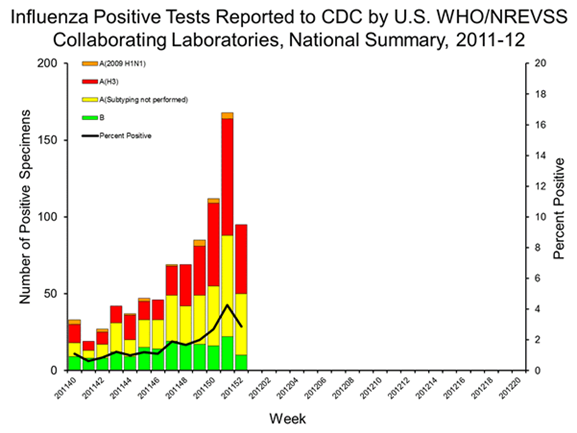
Courtesy CDC
A recent suggestion from WHO said an A-H5N1 pandemic “would be twice as virulent and deadly as the Black Death.”
How do we prepare for something so catastrophic? Such a pandemic would quickly overwhelm the Florida medical establishment and all sectors of society and the economy – including agriculture – would suffer. Without an effective vaccine or treatment, the best defense at present may be awareness and personal or family health measures.

In a recent article about the possibility of pandemic and millions of deaths, here is what Russia’s leading newspaper, Pravda, recommended in an online editorial.
* If you are sick, stay at home;
* Cough or sneeze into a tissue or the bend of your arm. Dispose of the tissue down a flush toilet;
* Wash the hands frequently;
* Use a sanitizing hand gel regularly;
* Wipe surfaces you touch upon arriving home with a tissue soaked in an alcohol-based substance or sanitizing hand gel: door handles, keys, light switches and water spigots;
* When outside, avoid touching surfaces where the flu virus can collect, such as door handles, elevator buttons, etc. Wear gloves and use sanitizing hand gel upon arrival in a building. Avoid touching the mouth or eyes.
Such preventive measures seem so pathetically insufficient and lack the comfort we would like. Yet even the deadly A-H1N1 bird flu strain is passed one person to another, one at a time. So while we wait for reassurance that an effective vaccination is available, we take the best available precautions and remain alert to potentials and consequences.
[top]
Okra and Random Email
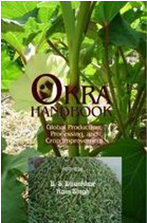
Do you ever receive random email? Probably, in today’s “all communication all the time” climate, you do.
On December 28th I received a note from HNB Publishing advertising Okra Handbook: Global Production, Processing, and Crop Improvement edited by B.S. Dhankhar and Ram Singh www.hnbpub.com/Science_files/8-0-TOC.html. It’s 475 pages and costs $110. If you want to give copies to friends and relatives, the email noted “bulk discounts available.”
Okra Handbook “is the first book exclusively on okra.” According to the American Society of Agronomy www.agronomy.org Okra Handbook “Synthesizes the scientific information on various aspects of okra…to provide in-depth information.”
Do we need or want a 475-page book about okra? The Florida Agricultural Statistical Directory makes scant mention of okra www.florida-agriculture.com/pubs/pubform/pdf/Florida_Agricultural_Statistical_Directory.pdf except that it is sold by the bushel and that a bushel weighs about 30 pounds.
Yet, I recall eating okra as a youngster, my grandmother both stewing it (which I hated) or chopping and frying it in corn meal (yum!). And you can occasionally find it on the menus of restaurants specializing in local cuisine or “down home” cooking or “family style” meals. So what’s the deal with okra?
No one can establish the certain “birthplace” of okra but it came to North America in the 18th century, was once grown as far north as Philadelphia and by 1800 was common in the South. (Thank you Wikipedia.com.)
An IFAS “Crop Profile for Okra in Florida” (by Michael Aerts and Mark Mossler) says that in 2004 production was estimated at 1,500 acres commercially, most in Dade County, although in summer it grows throughout the state. Yields range from 18-30,000 bushels an acre and the price per bushel that year was $18. If these figures are in the statistical ballpark, this little-known vegetable earned between $486 and $810 million. Not bad for such an under-the-radar crop!
Fun Fact about Okra: The IFAS report calls it a “scavenger crop,” which means it is planted in fields where more valuable crops have been previously cultivated to scavenge any fumigation benefits or residual fertilizer.
The Editors
[top]
And Of Note….
Farm Income Climbs
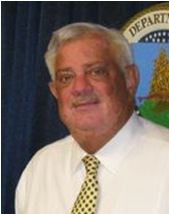
Tim Manning co-founded SART. He is now USDA/FSA State Executive Director for the state of Florida.
According to USDA Farm Service Agency State Executive Director and SART co-founder Tim Manning farm income in 2011 will reach an all-time high, up 28 percent over 2010. “American agriculture remains a bright spot in our nation’s economy,” Manning said. The growth in farm income means farm household income – up 3.1 percent in 2010 – should increase by 1.2 percent in 2011.
“Despite marginal increases in retail food prices, American families still pay substantially less for food at the grocery store than residents of nearly every other country thanks to the productivity of our farmers,” he said. A combination of factors has made this growth possible, including strong returns on cash receipts and off-farm employment, strong yields despite weather setbacks, and record high farm exports, which continue to make U.S. agriculture one of the only sectors of our economy to log a trade surplus year after year.
Today, farm exports support nearly 10 million or 1 in 12 American jobs and about 1.1 million in Florida.
UF Magazine Highlights Work of Julie Levy, DVM

Dr. Julie Levy, DVM, Director of the Maddie’s Shelter Medicine Program at the University of Florida (http://ufsheltermedicine.com) was featured in the Fall 2011 issue of Explore [Research at the University of Florida].
Levy led a study showing that a single-dose contraceptive vaccination could aid efforts to humanely manage free-roaming (feral) cat populations in the US. Check out the magazine and its articles at http://www.research.ufl.edu/explore/.
What's on your Florida salad? Tomatoes, Cucumbers & Bell Peppers
What's on your salad?
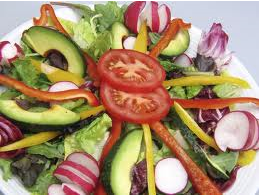
The agricultural outlook for Florida salad-makings is strong, but the future is a bit cloudy. Take your common salad-topping vegetables for example. “Despite the harvested acreage [of Florida vegetables] being down only two percent, production was down 13 percent [in 2009-2010] due to adverse growing conditions.”
A decade ago, in the 2000-2001 growing year, the total vegetable harvest in acres was 220,100. This year, the total vegetable harvest in acres is 151,400 acres – a decline of one-third.
- Harvested tomatoes in 25-pound cartons have declined steadily over the last ten years, but the return on a carton has practically doubled.
- The cucumber harvest in 55-pound bushels has been inconsistent, both rising and falling, while the price per bushel has slipped.
- The acreage in28-pound bushels of bell peppers has remained about the same, but the price per bushel has doubled.
| 2000-2001 | 2009-2010 | |
| Tomatoes
Acreage | 43,800 acres | 29,000 acres |
| Cucumbers
Acreage | 8,500 acres | 11,600 acres |
| Bell Peppers
Acreage | 18,200 acres | 17,700 acres |
Sources
1. Florida Agricultural Statistical Directory 2011 http://www.florida-agriculture.com/pubs/pubform/pdf/Florida_Agricultural_Statistical_Directory.pdf
2. For two informative, provocative and different points of view about Florida tomatoes, check out:
a. “Florida Tomatoes: Slice Into Some Sunshine” at http://www.floridatomatoes.org.
b. For a study of the difficulties agriculture in general and specifically the tomato face in Florida, read Barry Estabrook’s 240-page book Tomatoland:How Modern Industrial Agriculture Destroyed Our Most Alluring Fruit which is excerpted at http://www.npr.org/2011/06/28/137371975/how-industrial-farming-destroyed-the-tasty-tomato.
Extreme Weather 2011 – Days and Nights Warmer
In a speech in Denver in August, Dr. Jane Lubchenco, the administrator of the National Oceanic and Atmospheric Administration, NOAA, said that 2011 had “already hit the record for billion-dollar disasters — that is, droughts, floods, blizzards and other severe weather events that cause more than $1 billion in damage.”
In a “normal year,” hurricanes might contribute disproportionately to those numbers, but in 2011 the cost of disasters exceeded $35 billion before hurricane season had even begun in earnest.

Dr. Jane Lubchenco, NOAA Administrator
“The nation is increasingly vulnerable to extreme weather,” Lubchenco said, linking America’s vulnerability to the importance of financing for NOAA.
In the first half of August, 5,000 heat records were broken across the US, she said. About 2,000 of those were for the highest maximum temperature on a given day, and 3,000 were for the highest minimum temperature. This means nights as well as days have been getting hotter.
From January to July, 6.1 million acres across the country burned in wildfires, breaking the previous record by more than a million acres. At the end of July, 26 percent of the US was suffering extreme or severe drought conditions, while 33 percent was extremely or severely wet.
Lubchenco said these events underscored the need for accurate weather forecasting, which faces an uncertain future because of budget cuts.
[Crazy for weather? Take a look at this site for plenty of weather facts, trivia, games and information: http://www.accuweather.com/. And what about the end of the world in 2012 predictions? If it were true, rescuing a stray animal or worrying about crop insurance might be irrelevant, but for a great story about this go to: http://www.nasa.gov/topics/earth/features/2012.html.]
And speaking of rabies…
“North Carolina Veterinary Credentialed Responders (VCR) who rescue animals in natural disasters are at risk for animal bites and exposure to rabies. NC is enzootic with eastern raccoon variant rabies; terrestrial wild carnivores (raccoons, skunks, foxes, and coyotes) are the vector species that transmit throughout the state. Bats are also a significant carrier of bat variant rabies.
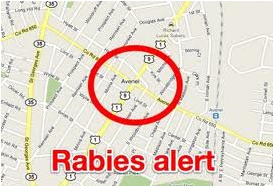
“The raccoon variant was first detected in NC raccoons … in 1991. From that point in time rabies spread through the state like wildfire as a result of two major epizootics that originated in Florida. The southeastern raccoon rabies epizootic, first detected in Florida (1947), crept northward up the eastern seaboard states … until it extended through most of Georgia and entered South Carolina by 1977, then moved into NC in the early 1990s. The mid-Atlantic raccoon rabies epizootic moved southward into NC from a hypothesized focus in West Virginia where a rabid raccoon had been trans-located from Florida for hunting purposes.”
[Excerpted from “Rabies Basics for Volunteers in Animal Disasters”
Dr. Marilyn Goss Haskell, DVM MPH, NC DHHS (read the full story at http://www.ncsart.org/)]
[top]
About the SART Sentinel |
The SART Sentinel is an e-mail newsletter prepared monthly by the members of the Florida State Agricultural Response Team. Past issues of the Sentinel are archived on the Florida SART Web Site www.flsart.org. If you have a story or photo that you would like to have considered for publication in the SART Sentinel, please contact the editors. Editor: Rick Sapp, PhD, Technical Writer under contract with the Florida Department of Agriculture & Consumer Services, Division of Animal Industry rsa5@cox.net. Associate Editor: Joe Kight, State ESF-17 Coordinator, Florida Department of Agriculture & Consumer Services, Division of Animal Industry Joe.Kight@freshfromflorida.com [top] |
|
|
